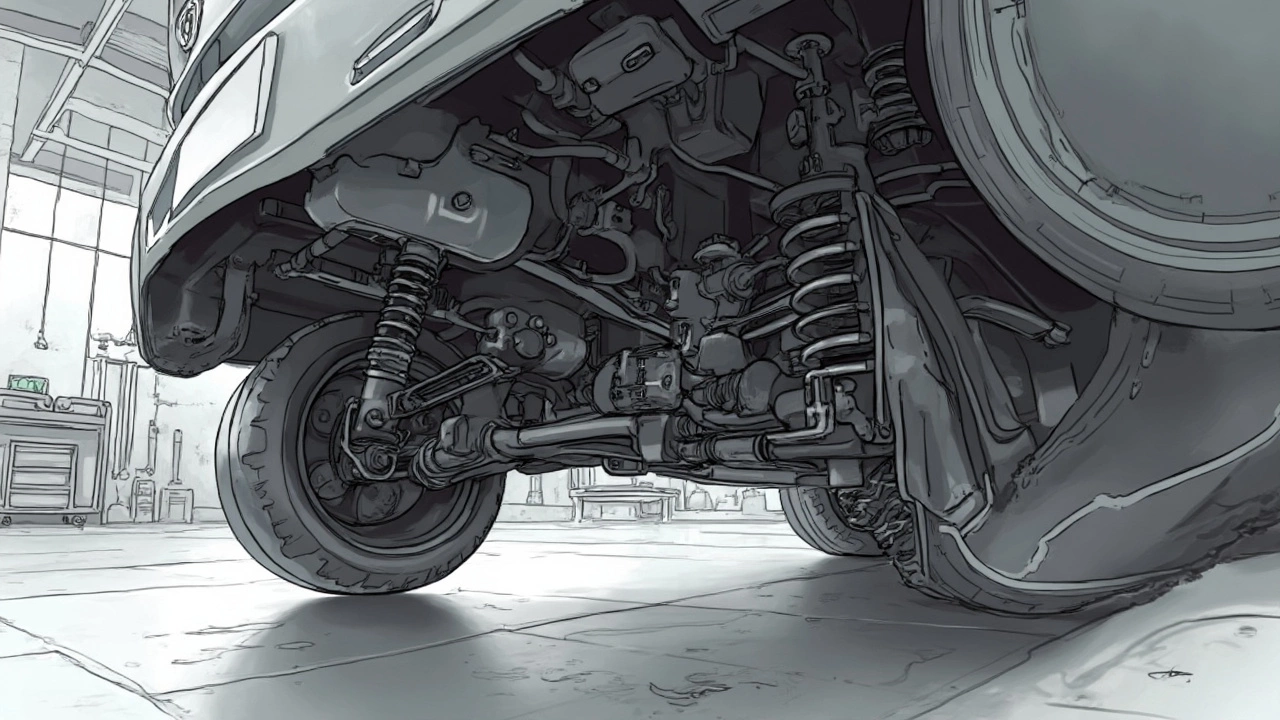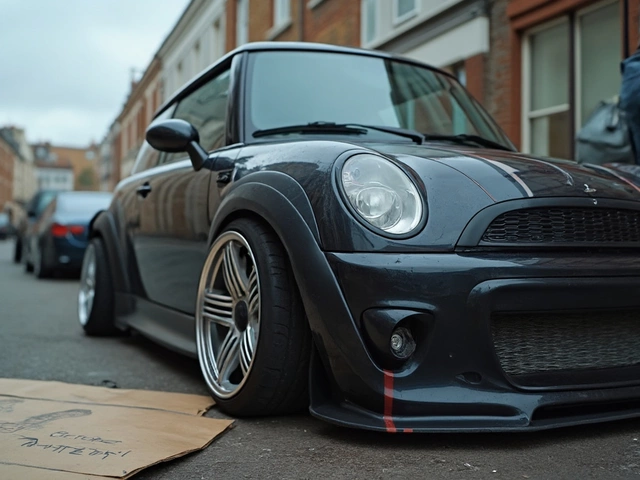Thinking about dropping your car's ride height with some fresh lowering springs? Before you grab that toolkit, there's a little detail folks sometimes miss: the humble bump stop. Ever wondered what these tiny parts do? Turns out, they play a pretty major role in keeping your ride smooth and your suspension healthy.
Lowering springs change how your car sits and handles, usually offering better grip and a sleeker look. But they also bring the suspension closer to the bump stops, which are there to cushion and protect the system from bottoming out. If you get that wrong, you might find your ride a bit harsher than you'd like.
So, what's the deal? Are new bump stops a must or just an added expense? Let's dive into how they work, why they matter, and whether you should consider updating them alongside those shiny new springs.
- Why Lowering Springs Matter
- The Role of Bump Stops
- Do You Really Need New Bump Stops?
- Tips for a Smooth Ride
Why Lowering Springs Matter
So, you've got your eyes set on those shiny lowering springs, huh? They might seem like just a cool upgrade, but they've got more going for them than just good looks. Lowering springs aren't just about giving your car a sleek, aggressive stance—they actually improve handling by lowering the car's center of gravity. This can result in sharper cornering and better stability at higher speeds.
By compressing the springs, there's less air beneath the car, which reduces wind resistance. This means better fuel efficiency over time, although it's not why most folks make the switch—gotta admit, the style points are a big draw!
Another perk? Improved responsiveness. With the car sitting lower, there's less roll in the corners. This setup delivers a firmer ride that many drivers feel offers more control and confidence behind the wheel.
- Handling: Lower center of gravity = better turning.
- Fuel Efficiency: Less drag on the road can mean better mileage.
- Style: Admit it, your car looks cooler lowered.
- Ride Quality: Can firm up the feeling on the road.
However, it's not all sunshine and rainbows. A lowered ride often means you'll have to be wary of speed bumps and potential scraping. But for many, the trade-off is totally worth it for that improved performance and look.
If you're pondering adding lowering springs, consider how important handling is to you versus everyday driving comfort. It's all about finding that sweet spot between function and style!
The Role of Bump Stops
So, you've probably noticed the little bump stops nestled in your suspension system. They might seem simple, but they do a crucial job. Essentially, bump stops are your suspension's safety net, preventing excessive pressure from causing damage when you hit a big pothole or a sneaky speed bump.
When you lower your car using lowering springs, you change the dynamics of your ride height, bringing the suspension closer to these bump stops. In a standard setup, bump stops are a rarely acknowledged component, only coming into play during intense compression. However, with lowered cars, they're in the game more often. If you've got the wrong size or type of bump stop, every small dip could feel like a giant crater on the road.
Bump stops function like the unsung shock absorbers. They help avoid the harshness of metal-on-metal contact within your suspension system. This not only protects the car but also keeps your teeth from rattling on rough roads. By maintaining the optimal position between your suspension and the road, they ensure that your ride remains as smooth as possible, even after making those sleek modifications.
Now, when should you consider replacing them? Often, stock bump stops aren’t designed for the reduced clearance that lowering springs create. They can limit suspension travel and cause your ride to be stiffer than intended. That's why many enthusiasts opt for performance bump stops designed specifically for lowered setups. These are usually shorter and made of materials that compress differently, allowing more suspension travel without losing the support bump stops provide.
Additional benefits? Proper bump stops contribute to more predictable handling, which is essential if you’re pushing your car’s limits. So, even though they might look like small rubber bits, bump stops actually have a big say in how your lowered car handles and feels.

Do You Really Need New Bump Stops?
Let's get straight to it: when you're swapping in those sleek lowering springs, the big question is whether your current bump stops can handle it or if you need an upgrade. Bump stops aren't flashy, but they play a crucial role by stopping your suspension from compressing too much, which can help avoid damage.
One thing to keep in mind is that lowering your car changes the dynamics of your suspension. The distance between the suspension components and the bump stops decreases, which might result in hitting the bump stops more often, especially on bumpy roads. If those stops are worn out or not designed for the new setup, you could end up with a clunky, uncomfortable ride.
So, how do you know if new bump stops are in your future? Here's a quick check-list:
- You notice excessive bottoming out after installing lowering springs.
- Your ride feels noticeably harsher, like hitting small bumps feels like bigger ones.
- The existing bump stops look cracked or damaged when you inspect them.
If you tick any of those boxes, it's worth considering swapping them out. Modern bump stops, like progressive bump stops, can offer a smoother transition and better performance by gradually increasing resistance as they're compressed. Plus, some manufacturers sell lowering spring kits that include bump stops specifically designed for the new ride height.
In the end, while replacing them might mean a bit more initial investment, it could save you from repairs down the road and give you a better driving experience. It’s like this: you wouldn’t put on a suit without checking if the shoes fit, right? The same goes for your suspension. Make sure every part of the setup works together for the smoothest ride possible.
Tips for a Smooth Ride
Getting your car’s suspension just right can feel like an art, especially when installing those sleek lowering springs. If you're aiming for both style and comfort, here are some practical tips to make sure your ride is as smooth as it looks.
First off, don't skip on a quality alignment after installing lowering springs. This ensures that your tires wear evenly and that your car handles well. Off-kilter alignment can make your ride bumpy and unpredictable.
- Check Your Tire Pressure: Keeping your tires at the right pressure can prevent unnecessary roughness. Under-inflation or over-inflation can mess with your car's handling, especially on lower setups.
- Upgrade Your Shocks: Stock shocks can sometimes struggle with lowered setups. Consider shocks designed for lowering springs to maintain a smooth and controlled feel.
- Trim or Replace Bump Stops: If your car feels like it's hitting bottom too often, trimming the bump stops or replacing them with shorter versions can give your suspension more room to maneuver.
- Mind Your Ride Height: Go lower, but not too low. Setting your car excessively low might invite trouble, especially with public roads that have bumps and potholes.
Kai Nishimura, a suspension expert, mentions,
"When modifying ride height, it's crucial to maintain harmony between springs, shocks, and bump stops. This balance is key to not compromising safety and comfort."
Still curious about how bump stops work with lowering springs? Imagine them like your car's safety net, catching it before it goes too far. Adjust them wisely to enjoy a responsive, but still comfy ride.
| Suspension Component | Recommended Adjustment |
|---|---|
| Lowering Springs | Choose reputable brands for consistent quality. |
| Bump Stops | Trim or replace if needed to accommodate new height. |
| Alignment | Always realign to prevent tire issues. |




